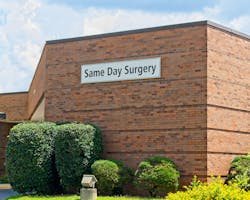Ambulatory Surgical Centers Adopt Digital Tools to Enhance Patient Engagement
As ambulatory surgical centers take on more complex procedures, they are increasingly turning to digital tools to help with pre- and post-operative patient care. An executive of Columbia Orthopaedic Group in Missouri recently spoke with Healthcare Innovation about their approach to patient engagement.
Administrator Andrew Lovewell said the Surgical Center at Columbia Orthopaedic Group (COG) is a. joint venture between Columbia Orthopedic Group physicians and national surgical hospital management firm ValueHealth, which has operations in more than 30 states.
COG expanded its surgery center in 2019, and opened a post-operative stay suite. ‘We'll do your surgery and discharge you. Then you check into the comprehensive stay suite where home health nurses educate you, make sure you're enrolled in our digital platform to where you can get exercises and instructions and your care team can monitor everything that's going on with you at home,” Lovewell said. “That has been pretty integral to making sure we get our patient engagement scores where we want them to be. I've been here three years, and we've added a lot of technology, expanded, added doctors, and added services.”
Once a patient decides that he or she wants to move forward with surgery, COG takes their information, and enrolls them in a program from a company called Force Therapeutics. “It launches an interactive interface with the patient and our care team — our nurse navigators and the doctor's office — to help the person prepare for surgery with strengthening their quads if they're going to have a knee replacement, for example, or knowing to how to prepare their home for when they come home for surgery,” he said.
The staff at the surgery center will make a follow-up phone call with them a few days before surgery to see if the person has any questions. “The person who's making that call is the same exact person who's messaging them through the whole process. We can say your nurse navigator is Julie, Julie's the one who's messaging you prior to surgery; she's calling you before surgery; she's messaging you after surgery; she's calling you after surgery,” Lovewell said. “You have a single point of contact that's not some arbitrary call center. You are able to talk to the person that you need access to. And she or he can relay that information to the doctor's office, if necessary. They can triage a lot of things ahead of time so you don't have to go to the ER or urgent care. They are continuing to monitor your progress and message you for about 90 to 120 days post-operatively. They also monitor your progress for a year to five years, depending on whatever protocol you're enrolled in.”
After the surgery, COG offers patients a free virtual physical therapy platform. “A majority of our patients love it,” Lovewell said. “There are some people who don't have a smartphone or a tablet, or just simply don't want to use technology, and that’s okay. I would say that's about 8 percent of our patients. But we're capturing 92 percent of our patients on the platform, and they're using it and rating it very highly.”
Lovewell said the technology deployment makes the surgical group more efficient because it reduces phone tag between patients and providers. “It's real time. As a patient you can see that Julie read my message and messaged me back in 7 minutes as opposed to being on hold at a call center. We want to give people an avenue to get to us faster, and for us to answer their question faster, so we can take care of more people.”
He said if the doctors and their staff buy into it and use the technology, it saves lots of time. “We have a super-user doctor, and he said it's lowered his call volume and his voicemails for his staff by 30 to 40 percent,” he added.
“There is a struggle with insurance companies paying for this,” he noted, “but at the end of the day, that's not what this is about. It’s more about giving that patient control of their post-operative plan.”
Post-surgery, some people end up going to the emergency room for things that are not emergent, Lovewell said. “That's frustrating to patients, because they haven’t gotten a resolution to their question, and they feel like they wasted their money and time waiting in the ER. It is frustrating to the ER, because there are patients who need to be there waiting for other people in front of them,” he explained. “This technology’s messaging component is open 8 to 5. Patients are looking for that sense of security that when a message is sent, someone's going to read it and get back to me. And during the day, our message turnaround time is short — 20 to 30 minutes on any issue. If it is a severe enough issue, we have escalation tools built into the engagement software. Now we can just triage concerns and tell them that bruising is normal; it is going to go down in a couple days.”
What’s next for COG in terms of tech deployments? “For patients who comes into the clinic, and they don't need surgery, or it is determined that they should try something else first, we don't have a tech solution for that right now, but that is coming soon,” he said. “That's going to be a huge thing for us, because we still see quite a few non-surgical patients.”


